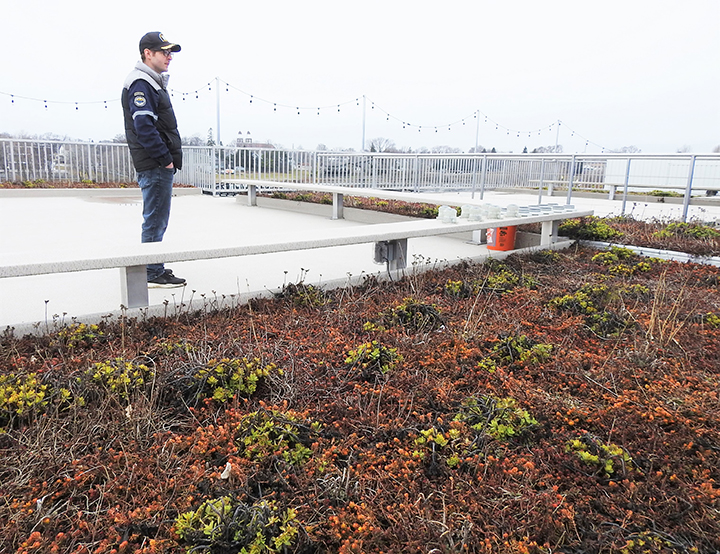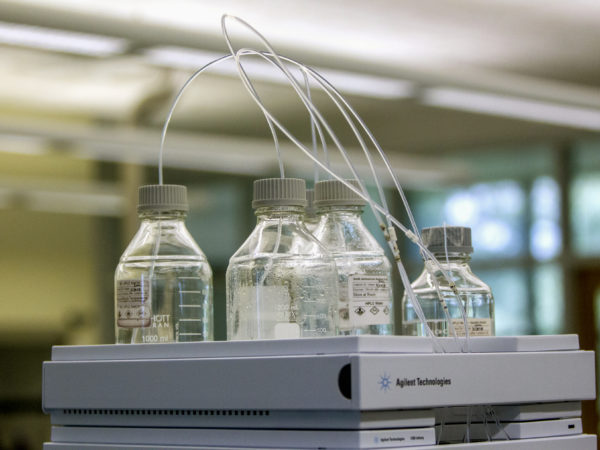
By Julie Riddle, The Alpena News
This article is part of a collaboration between The Alpena News and Great Lakes Now at Detroit Public Television to bring audiences stories about the Great Lakes, especially Lake Huron and its watershed.
ALPENA — Spring showers may bring spring flowers, but they can also carry pollutants into the lake that provides Alpena’s drinking water and many tourism dollars.
Thanks to a recent analysis of the underground path of the water that ends up in Lake Huron, Alpena residents can look forward to improvements that could keep chemicals out of the lake.
Residents can also do their part to protect the lake from stormwater-borne chemicals.
Even small changes by people who live near the big lake can make a big difference in blocking chemicals that, “over time, can add up to big problems,” said Samantha Nellis, water program director for Huron Pines, a Northeast Michigan environmental group.
Alpena-area water is healthy and beautiful now, but, without preventive action, that could change, Nellis said.

Courtesy Image A map of Alpena’s storm sewer system appears in this image provided by Huron Pines via The Alpena News
Courtesy Image A map of Alpena’s storm sewer system appears in this image provided by Huron Pines.
Rain and other water can carry phosphorus and nitrogen that promote algae blooms and endanger water clarity.
Ignoring runoff danger signs could lead to closed beaches, endangered fish, and a loss of tourism and fisheries dollars when people don’t want to come north to enjoy Alpena’s waters, Nellis said.
The city’s drinking water, which comes from Lake Huron, shouldn’t become dangerous because of increased lake chemical levels, but filtering those hazards out could cost more as chemical levels rise, she said.
In a report soon to be made public, Huron Pines will report the results of a 2021 assessment of Alpena’s stormwater system.
In the assessment, Huron Pines workers created a database of all gutters, inlets, and storm sewers carrying water into Lake Huron.
With that data, they mapped the city’s underground water system, which they then broke into zones resembling mini watersheds.
An analysis of each zone helped workers understand where water flowing into the lake originates and what areas of the city present potential danger to the lake.
The assessment detected several areas where outlets in bad repair allow chemicals and excess sediment into the Thunder Bay River or where concrete or grass alongside the river or Thunder Bay fail to slow pollutants carried by groundwater.
Zones containing many rooftops and cement slabs, including parking lots, allow water to pick up speed, its acceleration causing it to carry along more pollutants than slow-moving water.
City leaders have eagerly collaborated with Huron Pines to plan some infrastructure changes that could protect the lake from such hazards, Nellis said.
One potential fix, rain gardens, would use native plants to filter water diverted from parking lots. Instead of flowing straight into a storm sewer, that water would pass through the ground, the plants helping to remove some chemicals.
Downtown landscaping could someday incorporate tree trenches, underground structures that store and filter water under urban trees.
The city already houses one green roof atop the Great Lakes Maritime Heritage Center.
Such rooftops, planted with native plants that absorb rainwater, reduce runoff and increase the amount of water returned to the air instead of flowing to the river.
More such green roofs could be part of the city’s runoff response plan, Nellis said.
Huron Pines is working with an engineering firm to design possibile runoff-addressing infrastructure changes. The public will be invited to weigh in on those designs once artistic renderings are created, she said.
Catch more news at Great Lakes Now:
$3.7M grant to aid Lafarge port upgrades
SS Badger makes final Lake Michigan crossing of season
Featured image: Andrew Augustyn, visitor experience manager at Alpena’s Great Lakes Maritime Heritage Center, stands on the center’s green roof earlier this month. (Photo Credit: Julie Riddle/Alpena News)




